FutureVU Progress FY2020 (July 2019 – June 2020)
FutureVU embodies the university’s core values and holistic approach to planning. While FutureVU began as a campus land use plan or master plan, it has evolved to include developing spaces on campus and investing in initiatives that support the people who live, work and learn in them. More than building projects, FutureVU considers core themes such as sustainability, transportation and mobility, accessibility and more. FutureVU represents a high-level, holistic framework for the physical development of campus, while also contemplating core principles that align with our academic mission. Together, FutureVU and the Academic Strategic Plan provide a comprehensive vision for the university’s footprint and provide a basis for campus stewardship that enhances the university’s mission. While FutureVU implementation continues, this report offers a glimpse at Vanderbilt’s achievements in FY2020.
To view the FY2019 progress report, please visit the following page.
TRANSFORMATIVE PROJECTS
Central to the FutureVU vision are a series of transformative projects to address specific opportunities and challenges in each of the campus neighborhoods. FutureVU provides a consistent strategy and guiding principles necessary for the realization of all capital projects and changes to the built environment.
Most Academic Affairs capital projects originate in the schools and colleges with the exception of student housing and campus-wide strategic projects. All capital projects are aligned with the mission of the university, the goals of the Academic Strategic Plan and the objectives of FutureVU.
The university has a variety of capital and built environment projects underway. For more information on the capital project process, as well as academic affairs capital projects, please visit the following website.
Projects Completed in FY2020
- West End Neighborhood Transformation
- Phase 1 improvements to Peabody Neighborhood, including renovation of Six Magnolia Circle and Mayborn buildings, and a new accessible Connector Building
- Nicholas S. Zeppos College
- 1101 19th Avenue building renovations completed
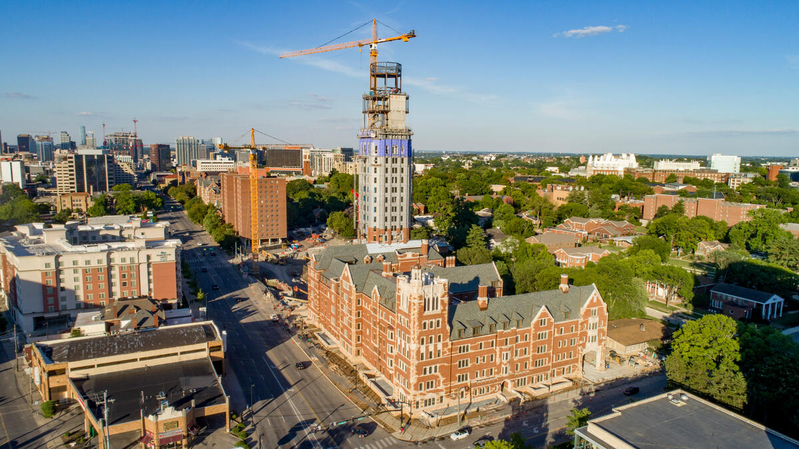
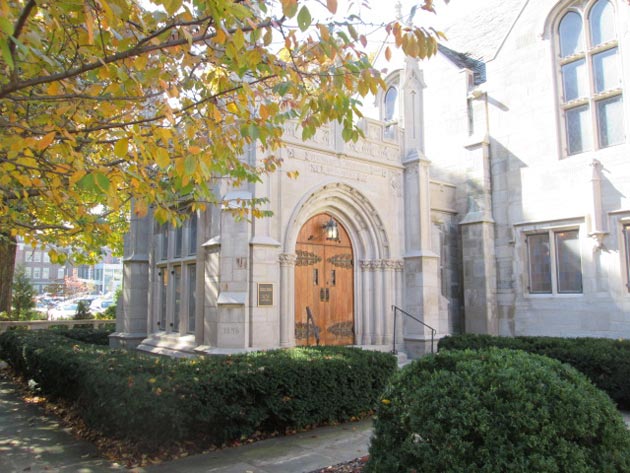
Projects and Studies Underway
- The expansion of the residential colleges in the West End Neighborhood.
- A&S/Historic Core and Sciences and Engineering next steps being considered.
- Re-imagination and visioning for the Central Neighborhood.
- Design of the Graduate and Professional Student Housing.
- Owen Graduate School of Management design underway.
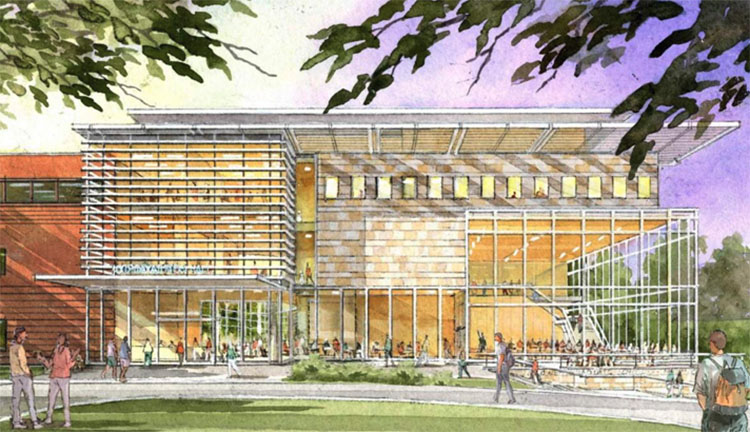
SITE, LANDSCAPE & STORMWATER MANAGEMENT
Overarching Site and Landscape Target
FutureVU builds on the park-like setting most notably found in the Historic Core neighborhood of campus. FutureVU aims to strengthen the beauty and diversity of campus by identifying and embracing existing open spaces and creating new open spaces, connecting edges and destinations in a legible manner, and opening visual connections throughout campus. In addition, increasing campus green spaces is a core component of the university’s long-term sustainability strategy.
Full Campus
Setting an overarching site and landscape target is necessary to achieving the goals outlined in FutureVU. The FutureVU framework calls for an overarching campus-wide target of 50% green space, 25% hardscape and 25% building footprint. As of the end of FY2020, the current campus breakdown is 38% green space, 33% hardscape and 29% building footprint. As development continues on campus, percentages will continue to be updated with the intention of achieving the campus-wide target.
Some key statistics to note for FY2020 include that 1.5 acres of roadways were removed from the West End neighborhood, and 1.4 acres of walkways added. Walkways added included permeable surfaces. It is expected that by the end of FY2021, a full analysis of before and after targets for West End neighborhood will be available.
landscape strategic plan

A key component of the FutureVU framework developed was a set of guidelines and goals for the university to consider for future development. Many of the targets outlined in this annual report correlate directly with the guidelines developed. One recommendation made as a part of the framework was for the university to develop a landscape strategic plan that sets standards for the campus outdoor spaces. These standards are accomplished by establishing long-term goals, maintenance standards, record keeping procedures, governance and targets for the university landscape. In fiscal 2020, the landscape strategic plan was developed as a subcomponent of FutureVU with the understanding that Vanderbilt is a university that resides in a unique and distinctive park-like setting. The landscape strategic plan seeks to strengthen and expand the university’s aesthetic character; identify memorable spaces and preserve them, while considering new memorable spaces; and ensure that future development reinforces the park-like setting. Efforts continue on this front, and now with the landscape strategic plan in place, the university is looking into next steps for the arboretum and much more.
West End Neighborhood
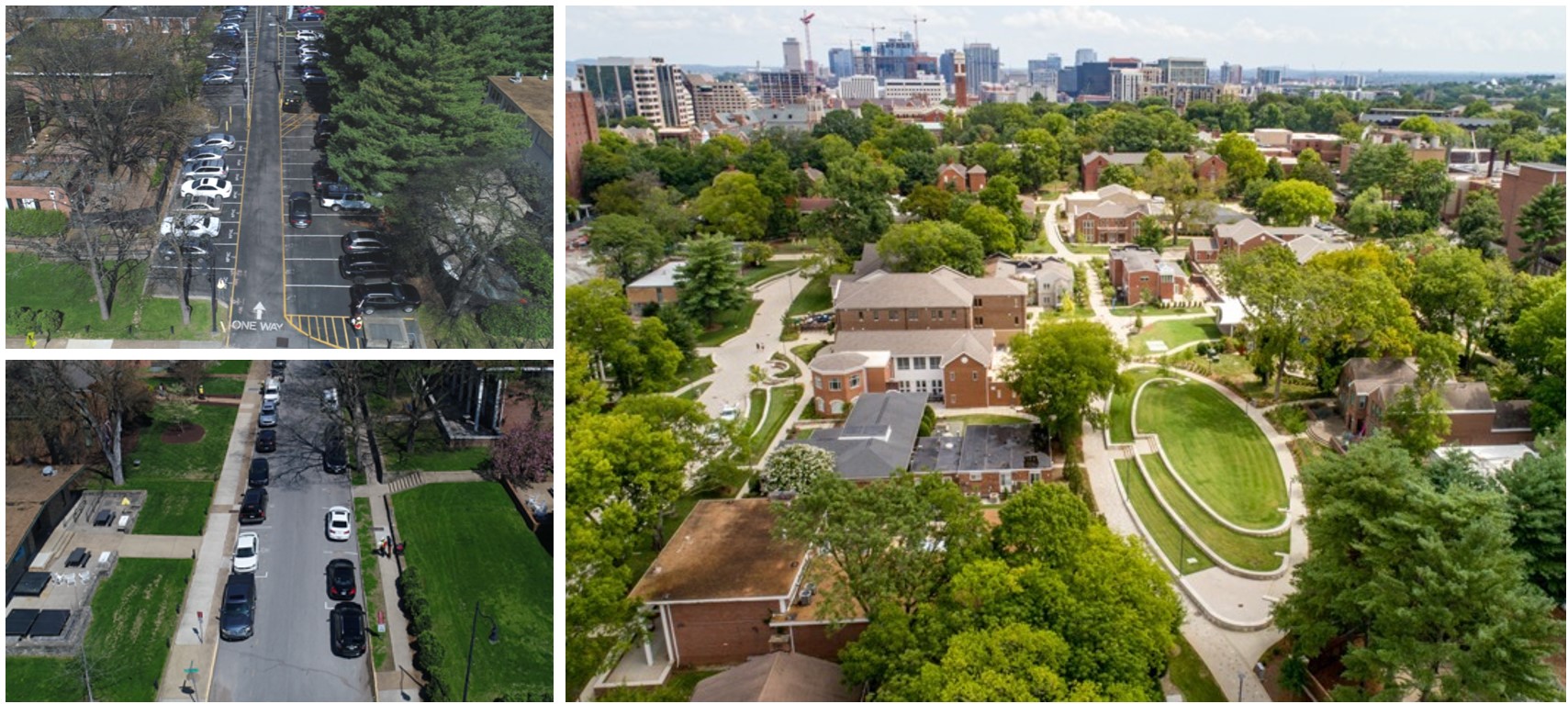
Neighborhood specific targets were also identified as part of the FutureVU framework. The West End neighborhood was one of the first neighborhoods to undergo significant transformation on campus. The re-imagination of the West End neighborhood includes a vision of expanding the park-like setting, as well as creating a positive, community atmosphere with an emphasis on accessibility. Consistent with the Academic Strategic Plan’s aim to enhance the undergraduate residential experience, three new residential colleges will be constructed along West End Avenue. The first of the three, the Nicholas S. Zeppos College, opened to students for the 2020-2021 academic year.
As part of the West End neighborhood beautification project, the neighborhood was transformed from a concrete jungle of alley ways, parking lots and roadways into a park-like setting with pedestrian-and bicycle-friendly pathways and outdoor collaborative spaces for the Vanderbilt community. A feature of the beautification was the removal of the roads Kensington Place and 24th Avenue South which are now wide pathways constructed of pervious pavers that connect the neighborhood with the historic and central part of the main campus. This project also renovated a number of the Greek life houses, constructed two new Greek Life houses and added a transportation roundabout to make access to the Rand/Sarratt Center easier.
The beautification of the West End Neighborhood was completed in Summer 2020 with the completion of the Green, Kensington Promenade and new bicycle-and pedestrian-friendly impervious pathways.
Stormwater Management
FutureVU considers stormwater management and water conservation core to landscape sustainability. Improved stormwater management can be tackled through a variety of methods, including:
- Canopy – slows water;
- Green spaces – absorb and slow run-off;
- Removing and limiting pavement – reduces run-off.
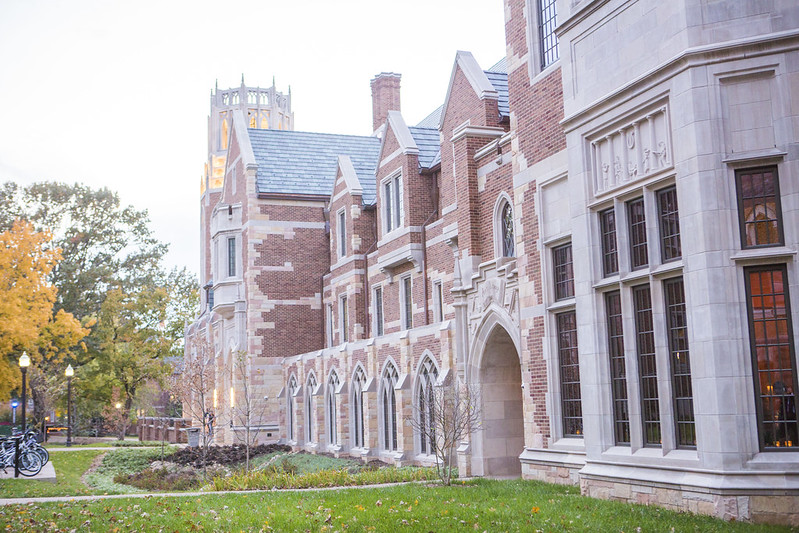
Stormwater can also be expressed as a design feature integrated in the park-like setting of campus. FutureVU aims to utilize a campus-wide approach to stormwater by implementing a variety of green infrastructure and low-impact development practices, such as bioretention areas, in order to achieve stormwater goals.
306 trees planted in FY2020
5,647 total trees on campus as of FY2020
6 total green roofs on campus as of FY2020
14 total stormwater management units (bio-retention) on campus as of FY2020
ENERGY AND GREENHOUSE GAS EMISSIONS
Energy efforts are core to FutureVU and the university’s long-term sustainability strategy to significantly impact its environmental footprint in part by powering its campus entirely through renewable energy. In order to achieve carbon neutrality by 2050, the university must invest in on-site clean energy and consider investing in off-site renewable energy.
In FY2019, two major studies were conducted including the BlueSky Energy Vision Study and the Large-Scale Renewable Energy Study.
Following those major studies, in FY2020, Vanderbilt entered into a pioneering agreement with the Tennessee Valley Authority and Nashville Electric Service to procure off-site large-scale renewable energy to help mitigate the campus’ greenhouse gas emissions. The 20-year agreement will support Vanderbilt’s goal to power its campus entirely through renewable energy. The renewable power will come from a solar farm to be built in Bedford County, Tennessee, by Nashville-based Silicon Ranch Corporation, the U.S. solar platform for Shell and one of the largest independent solar power producers in the country. Silicon Ranch targets fall 2022 for the facility to be operational. Vanderbilt is the first customer to partner with a local power company on this type of agreement in the seven-state TVA region. It is also the first agreement finalized under the TVA’s new Green Invest program. This initial partnership, announced in January 2020, will mitigate approximately 70 percent of the university’s annual indirect greenhouse gas emissions by fall 2022.
And while this report is focused on FY20 efforts, Vanderbilt recently, in the first-half of FY21, with the city of Nashville, Tennessee announced a Green Invest partnership with the Tennessee Valley Authority and Nashville Electric Service. The second Green Invest project will supply enough renewable energy to offset the remaining 30 percent of the university’s annual indirect greenhouse gas emissions from purchased electricity by fall 2023. This collaboration for both the university and the city of Nashville, will allow the region to take a bold step forward in expanding availability and access to renewable energy. The renewable energy for Vanderbilt and Nashville will come from a solar farm to be built in Tullahoma, Tennessee, by Nashville-based Silicon Ranch Corporation. This marks the university’s second solar project with TVA, NES and Silicon Ranch through TVA’s Green Invest program. Vanderbilt will be a. 25-megawatt co-subscriber to the array of campus operations. Vanderbilt will also reach its renewable energy goal just over four years after the university made its initial commitment in 2019.
20kW of solar panels on campus as of FY2020
23,218 kWh energy saved annually from solar panels
4 total solar picnic tables on campus as of FY2020
To learn more about the broader university sustainability goals, as well as review the annual sustainability report, please visit the FutureVU Sustainability website.
WASTE AND RECYCLING
FutureVU’s long-term sustainability strategy calls for reducing the consumption of waste on campus. Strategies are focused on everything from food waste, to elimination of single-use plastics, to landfill waste reduction, to improvements in the campus recycling program and changes in procurement strategies.
The university embarked on an extensive, collaborative process in FY2020 to examine the possibility of eliminating all single-use plastic water and soda bottles in campus operations throughout dining facilities, markets and vending machines. In early FY2020, Vanderbilt announced the elimination of single-use plastics, which was the result of a collaborative effort involving student organizations (SPEAR, VSG) and the Division of Administration (campus dining, facilities, SEMO). Efforts will save more than 430,000 plastic bottles per year and over 1.7 million bottles during a graduating class’s four-year experience. The amount of plastic saved in one year is enough to cover the university’s football field almost 1.5 times.
During the course of FY2020, the university embarked on an RFP process to determine the official beverage provider for its campus dining operations and vending locations. Providers were reviewed based on a number of factors, including addressing sustainability goals. In early FY21, Vanderbilt University announced PepsiCo as its official beverage provider for its campus dining operations and vending locations. The new agreement provides the entire university community with PepsiCo’s broad portfolio of beverages, including Pepsi, Gatorade, Pure Leaf iced tea, Mountain Dew, Starbucks ready-to-drink coffee, STUBBORN craft soda and more. A full transition of products took place before Aug. 1, 2020. This new partnership addresses the university’s sustainability goals and changing student needs.
20 BigBelly solar trash compactors added on campus in FY2020
64.8% waste diversion % in FY2020
136.2 tons of food waste composted
8 food waste collection sites on campus as of FY2020
167 total hydration stations on campus as of FY2020
SUSTAINABLE BUILDING
FutureVU considers sustainable infrastructure as an important element to ensure changes to the built environment are handled in an environmentally responsible and efficient manner. The university aims to impact the built environment in positive ways and minimize negative impacts as much as possible.
Vanderbilt’s E. Bronson Ingram College, which opened in FY19, was been awarded LEED Gold certification by the U.S. Green Building Council in FY20. The council’s Leadership in Energy and Environmental Design Green Building Rating System is the nationally accepted benchmark for the design, construction and operation of high-performance sustainable buildings. Organizations must apply for the certification, which is recognized as proof that a building is environmentally responsible and a healthy place to live and work.
21 total LEED certified buildings on campus as of FY2020
1 building designed to achieve WELL certification (certification pending) and opened in FY2019
1 building designed to achieve PETAL certification (certification pending) and opened in FY2020
Highlighted Sustainable Landscape and Building Project Completed in FY2020
the connector building
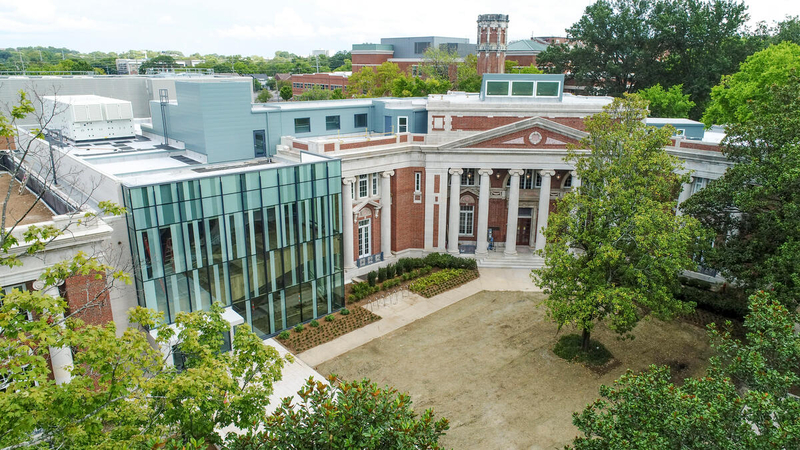
The university broke ground on Phase One of the Peabody Neighborhood project in September 2018. The historic Six Magnolia Circle, formerly known as the Home Economics Building, and the Frank W. Mayborn Building — each more than 100 years old – were completely renovated, and a new 15,000 square-foot building named the Connector Building was constructed between them. All three of these buildings were designed to reflect higher sustainability standards and reduce energy usage through new flexible, active learning spaces, advanced technology for modernized instruction, a digital observation space for teacher training, flexible research space, a café and administrative office. The Connector Building is also the first building designed to achieve PETAL design standards. Another part of this project was converting the original underground steam distribution system that ran throughout the neighborhood to hot water and installation of chilled water lines.
TRANSPORTATION AND MOBILITY
Issues of transportation and mobility are paramount to FutureVU efforts given the goals to beautify the campus, enhance the park-like character community members enjoy and better connect areas of campus that feel disconnected. FutureVU calls for the diversification of transportation options, prioritization of pedestrian mobility and improvement of accessibility. In addition, commute travel accounts for a significant portion of the campus’ greenhouse gas emissions (GHG), and reducing those emissions is paramount to the university’s long-term sustainability strategy.
During FY2020, the university developed and expanded upon programs as part of MoveVU, the university’s strategic transportation and mobility plan. The vision of MoveVU calls for providing more options and choices in how the Vanderbilt community commutes to campus – one with less reliance on single occupancy vehicles and less demand for parking – by offering a “daily decision” of travel mode choice. Providing options, flexibility and choices for Vanderbilt community members is integral to efforts.
FY2020 Accomplishments
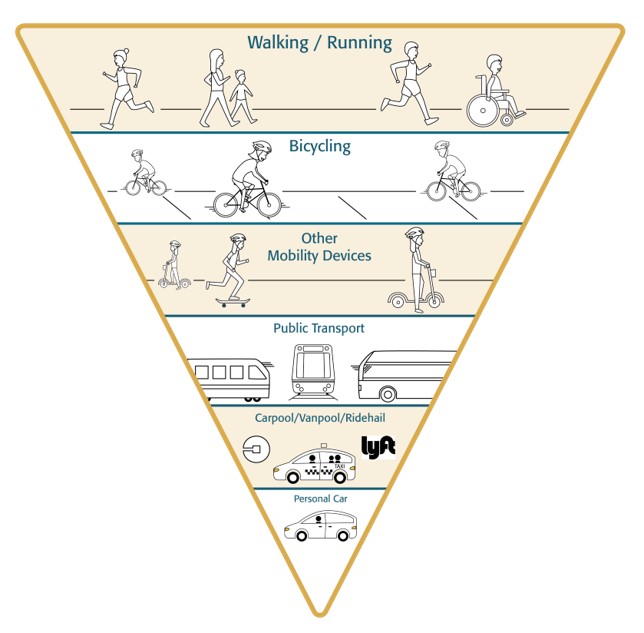
One of MoveVU’s goals is to shift the university’s mode share to increase the number of commuters taking sustainable commute modes and decrease the number of commuters driving single occupancy vehicles. The university’s 2025 daily mode share goal is to reduce the drive alone rate for commuters to campus from 76.5% to 55%, thereby reducing the need for the current amount of parking on campus, so that it can be reallocated to more mission-driven land uses. Land currently devoted to parking can be used for other purposes, such as increasing green space across campus, another fundamental component of Vanderbilt’s carbon neutrality goal, or building academic buildings and residential colleges as guided by the Academic Strategic Plan.
Another MoveVU Goal is for 80% of trips made on campus to be done via walking or biking, either for mid-day circulation trips or at the beginning or end of commute trips. In order to achieve this goal, the Transportation and Mobility office will work to make bike and other micromobility modes available on campus, ensure there are accessible pathways during every day and construction conditions, and improve campus infrastructure to support pedestrians and micromobility.
CMAQ AWARD & MAJOR STUDIES
After receiving an initial $4.5 million Congestion Mitigation and Air Quality (CMAQ) grant from the Tennessee Department of Transportation (TDOT) in 2018, Vanderbilt received a second award of $8.4 million in summer 2020 to scale up its MoveVU activities. The funding will enable the implementation of several MoveVU-related initiatives over its three-year period, including:
- shuttle service transit improvements,
- initiation of a bikeshare service,
- installation of traffic-detection technologies,
- data analytics to assess the efficiency and effectiveness of system operations,
- development of curbside management and micromobility policies and practices.
The Transportation and Mobility Office, in collaboration with the Parking Services team and other campus stakeholder, conducted studies on the nighttime shuttle service and the parking program during FY2020.
Shuttle Study
The nighttime shuttle service for students, formerly known as Vandy Vans, was restructured over summer 2019 to provide better service for students and renamed VandyRide. Updates to the service included earlier and longer service times, faster service and new routes. Routes with low ridership were consolidated, and other routes were changed to reflect the ridership trends of the study body, resulting in the creation of a Black route that circulates the campus and a Gold express route from Peabody to main campus. The team continues to monitor service and make adjustments as needed to reach maximum efficiency. The shuttle study also included examination of potential day time routes to serve commuters.
Parking Program Study
The Transportation and Mobility Office engaged in another study to comprehensively review all parking operations on campus. The study included a review of existing parking conditions to understand what is working and where opportunities exist. As part of the study, the team determined that peak parking occupancy is lower – 63% – than previously conducted occupancy studies, which suggests that steps can be taken to better utilize the parking spaces on campus. The team explored ways to create a culture of compliance on campus, standardize policies and procedures, utilize technology to manage data and make processes and systems more efficient, and how short term and flexible parking options can be added to the program to better align with the Vanderbilt community’s diverse needs. The study also included a review of the ADA parking spaces on campus. In addition, gates were installed in the Terrace Place, Wesley Place, and Sony Garages that will be used for a future daily parking option.
The team will implement changes to parking based on the study’s findings and feedback from the campus community. They will consider ways to better connect campus, prioritize accessibility and pedestrian mobility and ensure the campus’s limited, precious land is utilized for the highest priority items aligned with the academic mission of the university and adhere to FutureVU principles and values.
129 parking spaces removed in FY2020
294 total ADA parking spaces on campus in FY2020
Safety
Vanderbilt hosted the first installment of Walk Bike Nashville’s Vision Zero Nashville Speaker Series in May. Vision Zero seeks to eliminate all traffic fatalities and severe injuries while increasing safe, healthy and equitable mobility. The aspirations of Vision Zero align closely with MoveVU goals of improving pedestrian safety, connectivity and transportation in and around the Vanderbilt campus. The virtual meeting engaged participants in a conversation about which Vision Zero policies might be most effective for Nashville, as well as the state of the city’s roadways and how Vision Zero policies can improve traffic safety. Vanderbilt plans to participate in subsequent webinars in the Vision Zero Speaker Series.
Vanderbilt has continued to take steps on its campus toward achieving the Vision Zero goals of no pedestrian or bike fatalities or serious injuries. MoveVU and Vanderbilt University Public Safety conducted research on best-practices from peer universities and have participated in educational webinars as part of the #WhatsMyName campaign to improve ridehail safety and awareness. Pilot locations for ridehail pick-up and drop-off areas were identified across campus based on existing ridehail activity and in well-lit areas that can be easily monitored by cameras and VUPS patrols. This first phase of pick-up and drop-off locations will be monitored, and adaptations or new locations will be added as needed. VUPS also developed safety guidelines they recommend that riders follow when using ridehail services. Vanderbilt also collaborated with Metropolitan Nashville Public Works to pilot automatic pedestrian crosswalk signals at five major intersections around the university and along a portion of 21st Avenue South. Lastly, new electric golf carts are available to provide rides for those students, faculty and staff with medical or accessibility needs who have registered with and been approved. This is a joint project among Equal Opportunity and Access, Student Access, VUPS and the Transportation and Mobility Office. During FY20, approximately 163 mobility rides were provided.
9 dedicated ridehail pick-up and drop-off locations created on campus in direct response to requests from students to improve safety measures around the ridehail process
Signals have been programmed at 12 intersections to run on an automatic cycle in an effort to increase pedestrian safety as well as eliminate pedestrians’ need to press the crosswalk buttons
Repairs and modifications were made at the following intersections:
- Audible signals installed at crosswalks at Division & Broadway
- Repairs to the audible signal at 21st Ave. and Children’s Way
- Traffic signal added at 31st Ave. and Vanderbilt Place
- Traffic signal modified at 28th Ave. and West End Ave., including the addition of a dedicated turn arrow and no turn on red signal and a change to the light sequencing to prevent pedestrian-related incidents.
- Signal and timing change at Natchez Trace and West End Ave. to prevent vehicles from turning into Natchez Trace crosswalk while the crosswalk is active with a crossing light.
- Signal cycle changes were implemented at the following intersections to begin operating earlier in the morning to support commuting pedestrians to the medical center area of campus: 24th Ave. S and Children’s Way; 25th Ave. S and Children’s Way; Natchez Trace and Children’s Way
- WeGo Public Transit bus staging was moved from the intersection at 21st Ave. S and Terrace Place (near the Baker Building) to West End Ave. This operational change allows buses to queue on West End Ave. so there is enhanced visibility for pedestrians in the frequently used crosswalks on 21st Ave.
Infrastructure
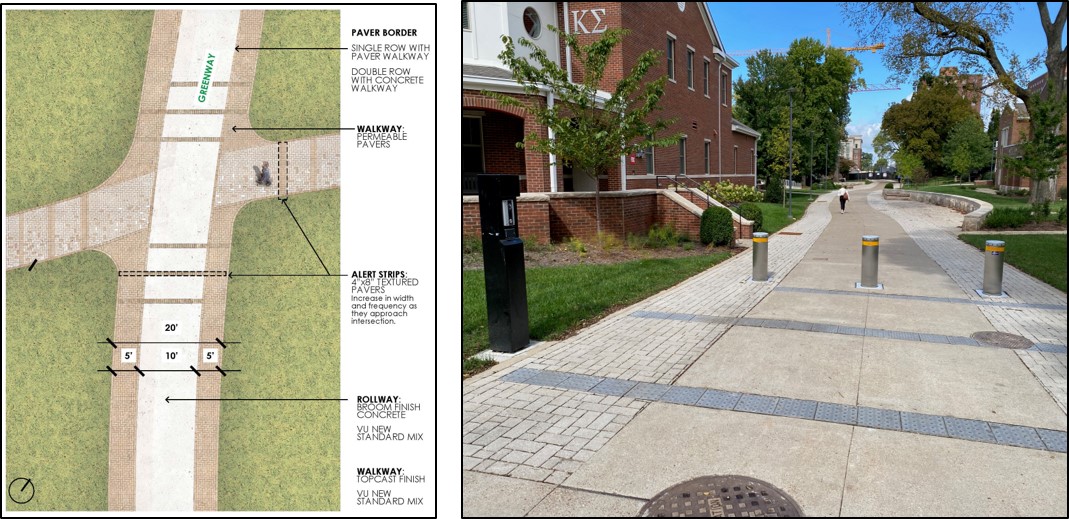
The university plans to develop a greenway network, building off the greenway concept foundational to FutureVU, throughout campus and a Walk and Roll Loop around the campus edge. This comprehensive, layered and connected mobility ecosystem is aimed at connecting neighborhoods, making campus more pedestrian and bicycle friendly and opening the campus edge to the surrounding community.
The first installment of the internal campus Greenway has been implemented as a part of the West End neighborhood transformation. 24th Avenue, between West End Avenue and Vanderbilt Place, has been converted to a pedestrian-centric Greenway.
The first installment of the Walk & Roll Loop is visible along portions of West End Avenue and 21st Ave. South near E. Bronson Ingram and Warren & Moore Colleges. Fences were removed to open the edge of campus to the surrounding community and a bike path and signage note the loop near 21st Ave. South.
30 designated parking areas for dockless bikes and scooters
7 total bike repair stations on campus, as well as shower facilities
sustainable transportation
Vanderbilt made important strides to open up more sustainable transportation opportunities for the Vanderbilt community during FY2020.
Vanderbilt has expanded its EasyRide program with WeGo Public Transit to make bus and commuter train trips more affordable and convenient for the university community. All full-time and part-time Vanderbilt University faculty, staff and students can now ride WeGo Local buses, WeGo Regional buses (formerly RTA), and the WeGo Star train (formerly the Music City Star) for free using their Vanderbilt ID cards. In addition, they can ride the buses and train for free with their Vanderbilt ID at any time, not only when commuting to and from the Vanderbilt campus.
In addition, Vanderbilt launched the MoveVU Commute Hub in February 2020 as a one-stop commuter information resource for the Vanderbilt community. The Commute Hub, which includes a new app and website that users can use to log their commute trips, allows Vanderbilt staff, faculty and students to better understand their commute options beyond driving alone—including WeGo public transit, bicycles, scooters, walking, carpooling and vanpooling.
The MoveVU Commute Hub is an essential component of the shift toward making a daily decision on how to commute to campus and will enable the delivery of a daily parking option, which the Transportation and Mobility Office spent much of FY2020 planning to launch.
ACCESSIBILITY AND INCLUSION
FutureVU aims to clearly contextualize inclusion in the built environment through careful space design. In May 2017, the university launched a comprehensive accessibility study with the long-term goal of making indoor and outdoor areas accessible and inclusive. The study was a multi-step process that included critically assessing and documenting different accessibility features on campus, integrating data collected with VU technologies and abilities to create an authoritative database for accessibility and other issues, and launching a task force to create an Accessibility Master Plan. The master plan was finalized and endorsed in FY2019.
highlighted BUILDING PROJECTS
Creating more diverse and inclusive spaces on campus is a priority of the university and embedded in the FutureVU principles. As new building projects are identified, accessibility and inclusiveness are important tenets and will be integrated into design guidelines.
An example of this at work includes the West End neighborhood redevelopment. Creating spaces to bring different groups of people together to foster community, such as new contemplative and green spaces, is integral to the design of the West End neighborhood. A new NPHC house, that is more central within the neighborhood, as well as community event space available for all students, are highlighted additions to the neighborhood. In addition, traveling from Alumni Lawn to West End neighborhood previously included many obstacles to pedestrians and a limited number of accessible paths. Updating the neighborhood design to address these issues was key to ensuring the university is enhancing accessibility in accordance with the recommendations from the Advisory Accessibility Task Force. The redesign included fully accessible paths from the Historic Core neighborhood through the West End neighborhood, the removal of Kensington Avenue and 24th Avenue South to create additional pedestrian and bicycle-friendly pathways, and construction of a transportation hub to allow for easier vehicular traffic flow in and out of campus.
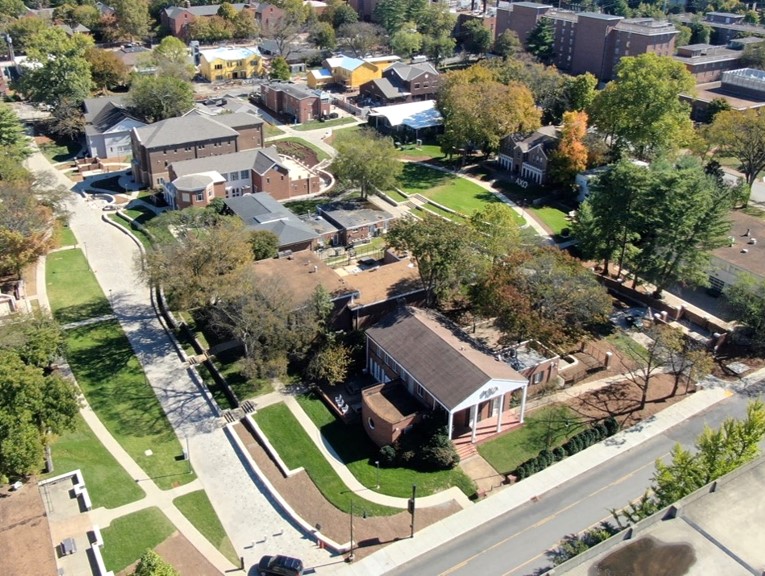
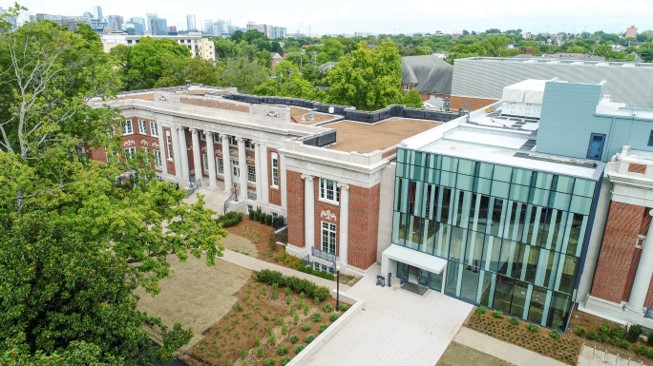
Another example of incorporating accessibility-related design principles into building projects is the Peabody Connector Building. The Peabody campus, and the majority of its buildings, are historic and many were not previously designed to reflect the university’s inclusive values. As the design team considered renovations to Mayborn and Home Economics, the following elements were incorporated into the future design of the renovated buildings, which included a new Connector building in between the two, to better meet the needs of all of the Vanderbilt community members:
- A multi-stop elevator was added to the Connector building, which provides accessibility to all floors in both buildings. There will be no difference in regards to access for a person with a disability or a person without a disability. Everyone will use the same route to enter the building and access all floors by the same means.
- A thorough examination of all relevant items such as accessible restrooms on all floors of each building, door hardware, restroom fixture locations, signage, water coolers, and exterior access ensures that any person with a disability is able to take full advantage of all amenities of the building.
- As exterior grading was reworked, slopes were eased to make the exterior access around the entire site more accessible for everyone.
Infrastructure Improvements
81 light poles were replaced in FY2020 as a part of capital projects
1,000 linear feet of sidewalk replaced/repaired in FY2019 and FY2020 combined
Additional Inclusivity Improvements
148 total gender inclusive restrooms on campus as of FY2020
24 total lactation rooms on campus as of FY2020
COMMUNITY ENGAGEMENT
Community engagement has been a founding pillar to the development of FutureVU. Similar to the academic strategic planning process, the land use planning process was open and inclusive, involving individuals from across the community (faculty, staff, students, alumni, trustees and Nashville community members). The land use plan represents innovative ideas that have emerged through collaborations with the Vanderbilt community. Broad consensus and support of the overarching guiding principles has been a cornerstone of efforts. Engagement has continued as the university embarks on the implementation of FutureVU.
FY2020 Engagement Statistics
Over 55 myVU articles on FutureVU efforts
530 social media posts related to FutureVU
Over 10 building project/construction related newsletters issued (West End neighborhood and Peabody neighborhood)
Over 25 key events held including pop-up events, town halls, advisory committee meetings, roadshows/open houses, webinars, bus tour